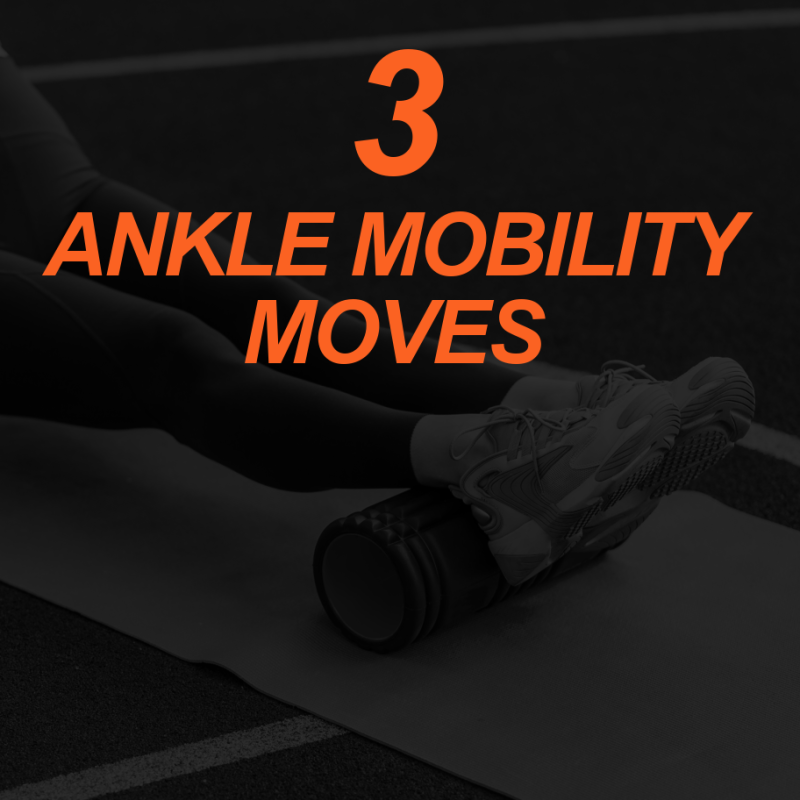
You may have to realize that your clients, or even yourself, have some significant ankle joint mobility limitations. Hopefully, you’ve also come to realize how truly signifcant ankle mobility is to move properly up the kinetic chain: Squats, running, even walking can be severely hindered by lack of optimal motion at the ankle. Here, we’re going to discuss the top three ways to improve ankle mobility. Whether the restrictions are due to capsular tightness or muscular tightness, each of these can be beneficial in regaining some of your coveted ankle dorsiflexion.
Improvements in mobility are rarely fancy.
Compressive self-myofascial release has been shown to be one of the top ways to improve ankle dorsiflexion. This may be done on a foam roller (the ones with texture or “knobs” work best on this tissue), a lacrosse ball, or other similar implements (even the handles of a kettlebell or dumbbell work reliably well).
Ideally, the target tissue should be relaxed during manipulation (although there are active approaches to SMR as well). That would mean that if you have a client sitting or lying while trying to roll out the back of their lower leg, try and make sure their muscles are relaxed; they’ll get much more out of it this way. An easy way to do this, is to instruct them to relax and let their foot drop. Once their foot drops, they should feel a difference in the soft tissue work.
As with any modality, test and retest with this method and ensure they “search and destroy” any trigger points they may find. Once they have spent 3-5 minutes on each side, retest that side with the assessment tools from the previous article.
The Virtues of Static Stretching
Static stretching has also been shown to be one of the most reliably successful means of improving dorsiflexion, intra-session. This can be done in any number of ways, but the simplest technique may simply be that of against a wall, or a slant board. If a slant board is not available at your facility, you have the client put the ball of their foot against the wall (with the other foot planted on the ground), or even a half ball (BOSU) with no shoes on (allowing the toe flexors to stretch as well).
Instruct your client to begin with a bent knee first in order to allow the soleus muscle to lengthen (as it does not cross the knee joint) before the gastrocnemius (which does). In this position of dorsiflexion, they should feel either the capsular tightness (many times in the front of the ankle) and/or the lower calf stretching. You may have them hang out here for 1-2 minutes, repeating as necessary. You may also have them perform dynamic mobilizations throughout the stretch by driving their knee towards the wall multiple times.
Following the bent-knee stretch, instruct the client to straighten the knee to allow the gastroc to lengthen in the same manner.
The Ringer: Ankle Joint Mobilizations
Ok, time for my favorite of them all. I typically will have clients first perform self-myofascial release, followed by some static stretching, and then hit the following movement for the ultimate trifecta!
You will need an elevated surface and a band for this exercise. You may have seen this before, but make sure you read thoroughly, because the majority of people I see completing this miss one vital element.
Setup the band around a fixed member, so that it may be pulled on. Then, get a box, bench, or any other elevated surface a couple of feet away from the band. Instruct your client to put their foot through the band and place that foot on top of the elevated surface. At this point, there should be some tension pulling on their leg from the band.
Ensure that they are facing away from the band, so the band is pulling their leg backward. Now, the important part. Instruct them to put the band on their ankle BELOW their ankle bones. If the band is left above the ankle bones, it will not allow the talus to glide (the intent here). So remember, always below the medial and lateral malleoli (the bony processes that protrude from either side of the ankle.
Now that they are in the right position, have them perform 10-20 mobilizations (driving their knee over their toes) with the band applying significant force backwards.
Now, go retest that ankle dorsiflexion and any other movement they displayed poor patterns in to see how this may have improved it for them!
Happy (dorsi) flexing!
References
https://pubmed.ncbi.nlm.nih.gov/29373060/
https://pubmed.ncbi.nlm.nih.gov/31935136/
https://pubmed.ncbi.nlm.nih.gov/24225348/






